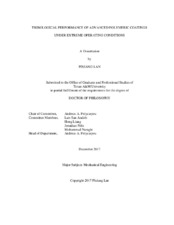| dc.description.abstract | Polymers and their composites have favorable tribological performance such as low coefficient of friction (COF) and good corrosion resistance, when working as bearing materials. The present work is studying the tribological performance of thin (~ 10s of microns) high-bearing polymeric coatings under extreme working conditions, including high temperature, cryogenic temperature, high contact pressure, high chamber pressure, starved lubrication, and abrasive wear. This work is an important contribution in proving the concept of application of thin polymeric coatings in environments such as dry sliding bearing, valve sealing surfaces, hydrodynamic bearings and drilling application under different extreme working conditions. Three groups of polymers, namely Polytetrafluoroethylene (PTFE)-based, Polyether ether ketone (PEEK)-based, and Aromatic Thermosetting coPolyesters(ATSP)-based coatings were extensively studied. Out of the three groups of polymers, ATSP-based coating showed the most desirable tribological performance: ‘zero wear’ at different temperature from -160°C to 260°C with dry sliding, extremely low wear coefficient (4.15×10⁻⁸ mm³/Nm) under starved lubrication condition, stable coefficient of friction (COF) and low wear rate under sand abrasive condition, and extreme low COF for oil and gas drilling application.
Traditionally, the friction force between two solids is attributed to adhesion and deformation effects; where the adhesion force involves the shearing between the real contact surfaces and deformation is due to the hard material‘s asperities plowing on the softer material. This work proposes a phenomenological model of friction for viscoelastic materials by using the viscosity and elasticity parameters acquired by nano-indentation measurements at elevated temperatures. Substituting the viscosity and elastic modulus terms, the model showed reasonable COF for the coatings up to temperatures that were lower than the glass transition temperature. | en |


